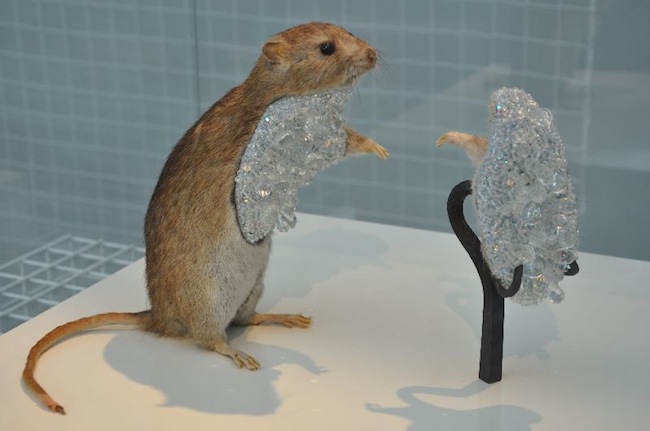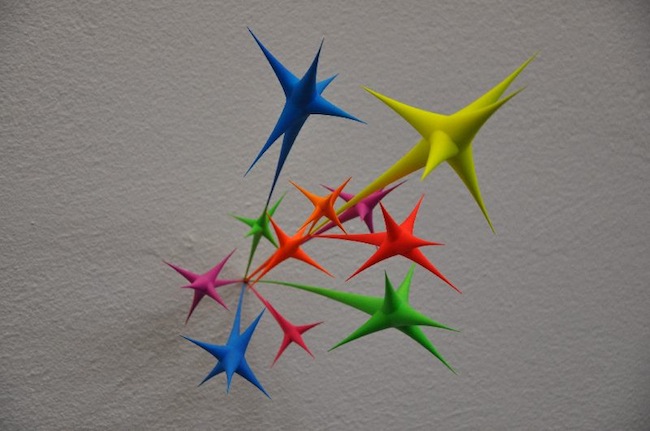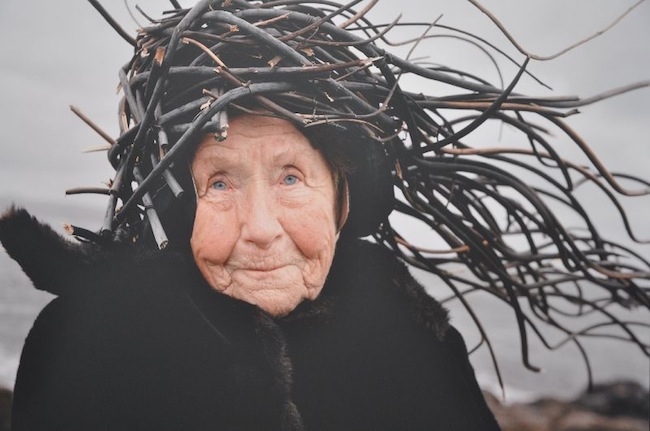
Traces of Camouflage
The Camouflage exhibition is on display at Helsinki’s KIASMA Museum of Contemporary Art until October 7
Have you ever shot at works of art? In a dream or in real life – with a compelling desire to destroy them? Like at a moving target in socialist era amusement parks, where a lucky hit directly in the heart (the bull’s-eye) would earn you a large, fluffy and synthetic bear. Camouflage, the exhibition currently on view at Helsinki’s KIASMA Museum of Contemporary Art, stirs up the instincts both literally and figuratively. In the most extreme version of events, it provides the opportunity to release your daily dem0ns and let them explode. That is, if you follow the guidelines, i.e. the description of the art work, and turn to the museum security staff between 2 and 3 pm, where you’ll receive a giant catapult, and after paying 20 euros, use it to shoot a piece of art – the target – into tatters. As a prize for your ‘heroism’, you’ll receive a t-shirt, thus becoming a “powerful actor, not a powerless observer”, as well as participating in the “destruction of a creative work of art”. To be fair, there is also a more subdued way to obtain the t-shirt, without satisfying any destructive tendencies – just visit the museum shop. In the good old rolling manner of consumer culture.
15 international artists are taking part in the Camouflage exhibition, and its conceptual basis is the fragile and often controversial boundary between art and design. Also, the camouflage of perception and interpretation, meaning that the same piece can often be given the status of either contemporary work of art or design object, depending on context. This once again starts up the ever pressing dispute on value. As the curator of the exhibition, Leevi Haapala, explains – “camouflage” denotes not just the classic military pattern, but also an integration or blending-in with the environment. “Camouflage in art is associated with visual deception and the strategy of concealing by exposing.”
Legendary fashion photographer Helmut Newton one had a series of X-ray photographs, through which he entered – literally - the hearts of his own obsessions, women in high heels. The photographer claimed that his ambition was to see/display how the frilly fantasy of fashion truly looks. He wasn’t content with just high heels, also piling Van Cleef and Arpels jewels worth millions on to the models and heading to the X-ray cabinet with this set-up… The precious jewels disappeared, leaving only their metal clasps and frames. There is also a place in the annals of fashion history for his 1994 photograph showing only perfectly groomed female hands with a Bulgari diamond bracelet and spectacular ring – with them, she is dividing up a cooked chicken, while a butcher’s knife lies nearby… At the time, this episode led to the jewelry brand threatening to stop placing their ads in French Vogue, where the image was published.
The motive of consumer culture ‘camouflage’ is also one that permeates the exhibition. In their Fake V (2007) series, Dutch artist duo Afke Golsteijn & Floris Bakker or Idiots play with the fragile boundary between life and death (and morals and permissiveness) in a simultaneously aesthetically beautiful and terrifyingly vulgar manner. Displaying stuffed animals in combination with expensive embroidery, pearls, gold, and crystals in cool, glamorous magazine-style settings. A stuffed ermine with a crystal décolleté, frozen in a sad gesture of worship – opposite the ‘lost part’ of his small body, now transformed into a crystal ‘magic frog’. Or a cross-section of a noble predatory cat, fossilized in crystals. À la Hirst, but in a more refined sauce of diamonds. By the way, some of the artist duo’s works once adorned the window display of a luxury store, once again making us think – if anything remains untouched by marketing n the modern worlds, it is likely some rare fossils somewhere in the Himalayas. And these have also probably only been saved only due to the conquerors in cutting edge trekking boots striding straight over them…
The Fake V project, like many of the pieces in the exhibition, comes together in its unique execution and quality of materials – at times almost with the level of precision of jewelry, almost giving them the status of fetish objects.
A true grand master of this niche is Finnish artist Jiri Geller, whose works are like a dazzling game with the symbolism of consumer culture. He attracts attention instantly, and is as contagious as a Disney cartoon. His works of art look like industrial products – a gigantic avalanche of goods made in China (in bright synthetic colors) at the supermarket – while in reality, they are all meticulously hand-made sculptures. Even more so, Geller does not have a brigade of executive ants; all his work is made by the artist himself. A nihilism-filled story of the surrounding world. The name of the series displayed at the exhibition is Sugared. A candyfloss and chemical caramel colored ‘dart’ rosary – the apogee of all addictions, resulting in the nauseatingly raw pink ‘sugar stomach’ displayed nearby. Brutal, hopeless pessimism in playful candy wrapper packaging.
Perhaps the factual coincidence that Camouflage is one of the central events of Helsinki – World Design Capital, suddenly brought to mind another exhibition seen four years ago, in Turin, the World Design Capital of 2008. The name of the show was Flexibility – design in a fast changing society, and it was located in a quite extravagant and somewhat symbolic place – a former prison built in 1867, now transformed into an art space. It theme was adaptation as a necessity in a century where nothing is stable and everything is in constant (unpredictable and even extreme) flux. The economic situation, whims of nature, individual lifestyles, human relationships, not to mention wars and global catastrophes. The exhibition space in the ex-prison’s corridors was right next to the former cells, whose interior remained unchanged behind the black curtains of the barred doors, creating a strange and stark symbiosis of emotions. I remember a Portuguese artist cleverly playing upon the concept of ‘mobile clothing’, using a former prison cell to display ascetic white cotton dresses, which could be turned into wearable pieces of art during life’s festive moments with the help of simple markers. That is, one has only to place the open markers in small pockets, and in an hour and a half, the ‘print’ in the form of colored circles (9-12cm in diameter) is complete.
Four years is at once a short and a long time. However, it is entirely long enough for some supposedly conventional values to turn head-over-heels, and simultaneously – time to get used to so much. Camouflage, which inspired the name of the exhibition, was created to help the military survive. It began as an attempt to blend in with nature – its pattern varying depending on the location of the battle. Camouflage (a word borrowed from the French) has its origins in the First World War, w hen the artillery used it to hide from enemy air strikes. Everything – people, equipment – was placed under the material simulating trees, shrubs and leaves. The first camouflage jacket was said to be painted by hand by a French soldier. Between 1970 and 1985, there were already more than 30o variations of camouflage used by armies throughout the world. Cold-bloodedly, it also took over fashion, almost vying in popularity with jeans. Paradoxically, at different points in time camouflage has been an equal infatuation both for those involved in the production of consumer cult toys, as well as those passionately in opposition to them. While on the military front, camouflage is an ingredient of survival and victory, on the street it has always been a sign of rebellion – against the system, war, or violence. Andy Warhol also used camouflage in one of his very last self-portraits – in the father of Pop Art’s games with the consumer toys of the time, it served as a kind of protective greasepaint for him.
However, in contrast to the battlefield, it seems that the everyday life of the metropolis does not hold such specific and brutal enemies, but instead a typical everyday struggle for survival that begins at the moment you exit the front door of your high-rise building (or private house)… The degree of difficulty is also not quite existential, but just the order of the day – stress, pollution, human loneliness, industrial chaos, lack of time. In any case, being properly equipped means being properly prepared – the jungle remains the jungle, after all.
In the Camouflage exhibition, camouflage itself appears only up to a point – a stylized white, minimalistic interlayer netting, rather providing a light ‘design fog’ effect, and thus wittily dissipating the sometimes outright self-sufficiency of the objects displayed. Also, creating a clear sense that the conceptual ‘camouflage’ serving as a unifying element for the show by describing the hybrid space between art and design, is but a wonderful verbal ‘powder’, possibly hiding a very different camouflage. The camouflage of daily life we are all living in – spreading it over our faces like SPF sunscreen or lipstick, an entourage of clothing and design conforming to up-to-date lifestyle currents (talking just about fashion is not the style anymore). Or a seemingly equally acute denial of it all… Like a rabbit, hiding any tracks and in the end no longer sure of the fragile line between “who am I” and “who I pretend or imagine myself to be”.
Photographs of wrinkled, grey-haired folk form one of the most emotionally powerful and poetic pieces in the exhibition - Finnish photographer Riita Ikonen’s work, inspired by the nature and folklore of south-western Norway. Their headdresses imitate ancient tales and legends – out of the blue, a haystack comes to life or a boy turns into a bundle of sticks... The biddy whose head is covered by a ‘hat of sticks’ seems to have experienced as much in her life as the tree her headdress comes from. Her eyes hold the dim blue of the universe. Meanwhile ,the ‘string’ of the straw ‘bonnet’ appears to be painfully chafing her neck. Her gaze is directed upwards and it seems – any minute now she will disappear, vanish into infinity, leaving only traces of the camouflage of a once lived life (and time).


